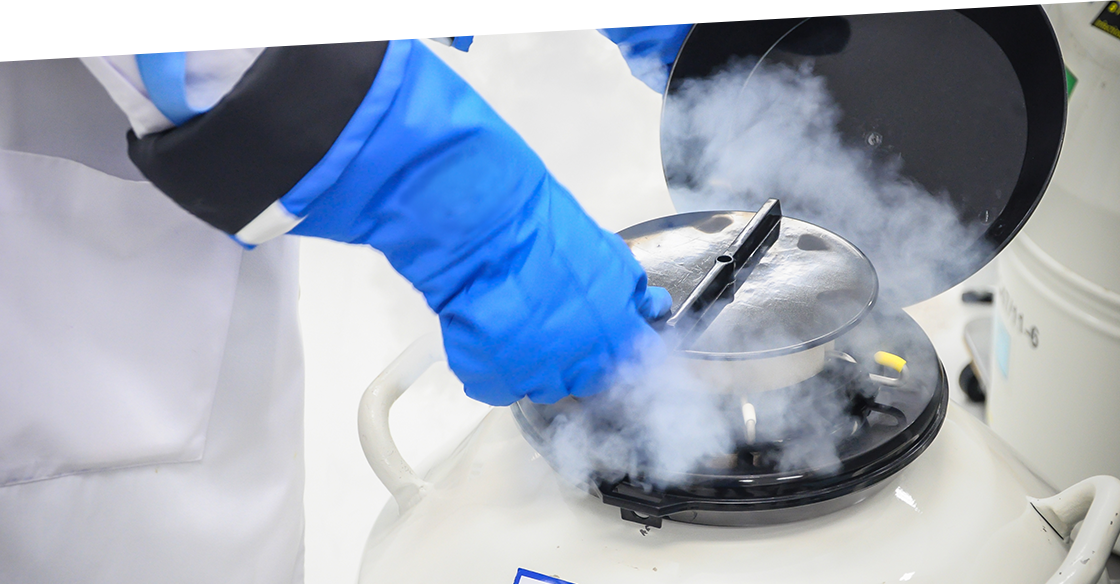
For professionals in the pharmaceutical and biotechnology sectors, safeguarding sample integrity is fundamental. The commitment to preserve scientific assets not only enhances reproducibility, it also minimizes variability, both essential components for ensuring the reliability and credibility of your research endeavors.
Revised: February 28th, 2024
How to Reduce Risks Associated with Cryogenic Storages
Cryotanks serve as the backbone of sample preservation. This type of cold storage solution is designed to keep your samples viable over extended periods. However, navigating the complexities of these critical units requires a meticulous approach to risk management. Our goal is to illuminate the nuances of cryotank storage, emphasize the importance of proactive monitoring, and introduce effective tools and methods that safeguard your samples while ensuring adherence to industry best practices.
Cryogenic Storage Composition
Cryotanks are sophisticated storage units. The basic structure of a cryotank consists of two shells, an inner shell and an outer shell. The inner shell (usually made of stainless steel) is the sample or asset container and the outer shell (usually made from carbon steel) is the vacuum jacket. Air is removed from the space between the two shells to create a vacuum, which helps provide extraordinary thermal insulation. Even with its seemingly simple construction, there’s much that can go wrong, and when it does, the costs can be astronomical and the losses are irreplaceable.
The potential for equipment failure, human error, and the natural wear and tear of time pose significant risks. Recognizing these vulnerabilities is the first step in a comprehensive strategy to mitigate risks, encompassing regular maintenance, ongoing training, and the implementation of a monitoring system that provides support.
The Importance of Probes in Cryotank Monitoring
Ensuring sample integrity in cryotanks hinges on the precision and reliability of the monitoring equipment used. Probes in particular play a vital role in this ecosystem – they safeguard against equipment malfunction and ensure that cryotanks maintain their critical temperatures. 
In addition to temperature monitoring, probes can also monitor the LN2 levels. This provides alerts when the LN2 is close to complete evaporation — a situation that can cause temperatures to rise rapidly and potentially compromise the samples. The dual function of probes as both monitors and alert systems is essential in maintaining the stringent conditions required for cryogenic storage, where maintaining precise temperature control is critical.
Purpose-Built Probes Promote Reliable MonitoringThe crux of effective cryotank monitoring lies in the use of purpose-built temperature probes. The question every facility must ask is not whether they have probes, but whether their probes are explicitly rated for the specific cryotank and the conditions it will encounter. The compatibility aspect of a probe with its environment is a fundamental requirement. A probe that is not designed for the specific temperatures and conditions of a cryotank may fail to provide accurate readings, leading to false assurances or unnoticed deviations. This can compromise the quality of your science and increase variability. |
Addressing Cryotank Failures & Challenging The Status Quo
Facilities must critically assess their current monitoring systems and ask themselves if they truly meet the needs of their cryotank’s requirements. It's not just about having the right probe, it's about having the right monitoring system and active management technology to help build redundancy and reliability within your facility.
In 2023, a Swedish University experienced a massive loss following a cryogenic tank failure. This loss has set leukemia research back nearly three decades. With losses estimated at £37 million, this highlights the importance of establishing a reliable monitoring system. Don’t wait for a wake-up call in the form of equipment failure or asset loss. The cause of this research loss was due to an alarm malfunction that only notified the users via email, they never received a text. If they partnered with a provider that offered live agent support, the team of monitoring experts would have reached out to users via call, text, and email until the situation was resolved.
In 2018, a fertility clinic in Cleveland lost over 4,000 embryos following a tank failure that occurred during the weekend while no one was in the lab. This catastrophic failure affected 950 families, and the cryotank failure was not addressed because the remote alarm that was meant to alert the employee was turned off.
Tragedy struck again in 2018 when another fertility clinic in San Francisco experienced a tank failure that led to the loss of 3,500 eggs and embryos. Both losses could’ve been prevented had these facilities partnered with an equipment monitoring provider that have an 24/7 active management service.
Confronting Risks with Knowledge and Preparedness
As with most heavy-duty lab equipment, there are more than a few risks involved in using cryotanks, and ensuring you’re monitoring each tank is critical.
Frostbite or Cryogenic Burns: These are possible if cryogenic liquids come into contact with the skin. Cryogenic liquids can cause major damage if they come into contact with other equipment or the infrastructure of a laboratory, such as pipes, laboratory benches, and laboratory floors (this is a rarity, but it can happen).
Asphyxiation: This can occur if liquid nitrogen is used or released in a poorly ventilated area. Liquid nitrogen can rapidly evolve into nitrogen gas, and the gas can then displace the oxygen in a room, leading to asphyxiation.
Explosion risk: There is an explosion risk due to rapid pressure changes that can occur within cryogenically stored liquefied gas. Cryotanks are usually fitted with pressure release valves (which can and should be monitored), so if the pressure begins to build up inside them, it can be released gradually and safely in a controlled manner.
Cryotank Explosion: The Risk Realized in a Texas Lab
Cryotanks exploding is not theoretical. A widely circulated accident report following an explosion involving one of these tanks highlighted a number of serious errors that any lab should be on the lookout for.
The accident occured at Texas A&M University in 2006, and the cryotank involved was beyond its service life, emphasizing the point that cryotanks have a definitive lifespan and must be decommissioned and replaced after reaching it. Compounding the risk, the tank's pressure release valves, had malfunctioned previously, but hadn’t been replaced. Instead, they sealed the tank with metal plates, a decision that proved to be flawed.
The pressure in the tank started spiking at 3:00 a.m., and there was no one on-site to monitor. With no properly functioning pressure release valves, pressure built up until the tank propelled like a missile through the building. The tank's journey ended on the third floor, but not before it had caused extensive damage. The explosion was powerful enough to strip tiles from the floor, disrupt water mains, sever electrical cables, and even crack concrete ceilings. The scale of the damage was immense, painting a vivid picture of the potential danger posed by neglected cryogenic storage facilities.
Luckily, the timing of the explosion meant that the building was unoccupied, averting a potential tragedy involving human casualties. If these tanks had been properly monitored and risk-assessed, this incident could have been entirely avoided. This narrative is a lesson that should guide us towards more stringent safety measures and the continuous improvement of our monitoring and maintenance protocols.
Protective Measures for Cryotank Safety
Explosions, leaks, and asphyxiation pose significant risks in laboratory environments, but proactive measures can greatly reduce the likelihood of such lab disasters. Clinical lab managers have several strategies at their disposal to safeguard their facilities, equipment, and personnel:
Training: All users interacting with cryotanks must receive comprehensive training on their proper handling and the associated equipment. This includes adhering to safety protocols and wearing appropriate protective gear to mitigate risks.
Maintenance: Regular maintenance is crucial to ensure all equipment operates at peak efficiency. Adhering to a planned maintenance schedule, typically provided by the tank manufacturer, helps prevent issues. Addressing any signs of damage or wear ensures that minor issues don't escalate into major problems.
Cryotank Management: Preventing nitrogen levels from falling too low is essential since it could jeopardize the stored samples. Implementing daily tank inspections, continuous monitoring systems, and providing access to live support for alarm interpretation can significantly enhance sample safety.
Ultimately, effective risk mitigation in cryotank storage revolves around constant vigilance. Continuous, round-the-clock monitoring of cryotank functionality and temperature is crucial to prevent critical asset loss. Fluctuations in temperature can lead to immediate and severe consequences, such as chromosomal damage, destruction of tissue samples, or the formation of ice crystals in cell cultures. Prompt detection of any temperature deviations is key to maintaining sample integrity and achieving favorable outcomes.
How XiltriX Helps Mitigate Cryotank Storage Risks
Through Monitoring-as-a-Service, XiltriX provides full operational oversight and acts as a second line of defense by enhancing security and prioritizing the customer’s peace of mind.
The XiltriX alarm escalation protocol alerts the users in your lab of any issues in the lab. XiltriX leverages real-time data from temperature outputs and other parameters relating to cryogenic storage systems to:
- Produce automated reports
- Help labs adhere to regulatory requirements
- Receive alerts to changes in LN2 level, pressure, energy consumption, or ambient O2 concentrations
- Improve quality control and assurance
- Simplify the audit process
Cryotanks are becoming more and more critical in the modern lab. Learn more about them, and other cold storage solutions, in our eBook, Lab Equipment Monitoring - the Ultimate Guide.
